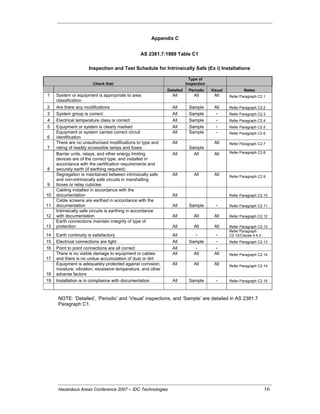Roar Solutions Things To Know Before You Buy
Roar Solutions Things To Know Before You Buy
Blog Article
The 5-Minute Rule for Roar Solutions
Table of ContentsThe 7-Second Trick For Roar SolutionsNot known Facts About Roar Solutions5 Easy Facts About Roar Solutions Explained
In order to shield installations from a potential explosion a method of evaluating and categorizing a potentially hazardous location is required. The function of this is to guarantee the correct option and installment of devices to eventually avoid a surge and to make certain safety and security of life.
(https://au.enrollbusiness.com/BusinessProfile/7095102/ROAR%20Solutions)
No tools ought to be mounted where the surface area temperature level of the tools is greater than the ignition temperature level of the provided threat. Below are some usual dust hazardous and their minimal ignition temperature. Coal Dust 380C 225C Polythene 420C (melts) Methyl Cellulose 420C 320C Starch 460C 435C Flour 490C 340C Sugar 490C 460C Grain Dirt 510C 300C Phenolic Resin 530C > 450C Aluminium 590C > 450C PVC 700C > 450C Soot 810C 570C The chance of the risk being present in a focus high enough to trigger an ignition will differ from place to place.
In order to categorize this threat an installment is split right into areas of risk relying on the quantity of time the unsafe is existing. These areas are described as Areas. For gases and vapours and dirts and fibers there are three areas. Area 0 Area 20 A hazardous ambience is extremely most likely to be present and may be present for extended periods of time (> 1000 hours per year) and even constantly Area 1 Zone 21 A dangerous atmosphere is possible but unlikely to be existing for extended periods of time (> 10 450 C [842 F] A classification of T6 indicates the minimum ignition temperature is > 85 C [185 F] Dangerous area electric equipment possibly made for usage in greater ambient temperatures. This would indicated on the rating plate e.g. EExe II C T3 Ta + 60C( This implies at 60C ambient T3 will not be exceeded) T1 T1, T2, T3, T4, T5, T6 T2 T2, T3, T4, T5, T6 T3 T3, T4, T5, T6 T4 T4, T5, T6 T5 T5, T6 T6 T6 A T Course rating of T1 suggests the maximum surface area temperature level created by the instrument at 40 C is 450 C. Assuming the connected T Class and Temperature level ranking for the devices are proper for the area, you can constantly use an instrument with a much more rigid Division ranking than required for the area. There isn't a clear response to this concern unfortunately. It really does rely on the sort of tools and what repair services need to be executed. Tools with certain examination procedures that can not be performed in the field in order to achieve/maintain 3rd party ranking. Must return to the manufacturing facility if it is prior to the tools's solution. Area Repair By Authorised Employee: Complex screening might not be needed nevertheless certain treatments might need to be followed in order for the devices to preserve its 3rd party rating. Authorised employees must be used to carry out the work appropriately Repair service need to be a like for like substitute. New part need to be thought about as a straight substitute needing no unique screening of the tools after the repair work is total. Each item of tools with a dangerous rating ought to be assessed independently. These are described at a high level below, but also for even more thorough details, please refer directly to the standards.
4 Easy Facts About Roar Solutions Described
The equipment register is a comprehensive data source of devices records that consists of a minimum collection of areas to determine each product's location, technical specifications, Ex lover classification, age, and environmental information. This information is crucial for monitoring and managing the tools effectively within harmful areas. On the other hand, for routine or RBI tasting inspections, the grade will be a mix of In-depth and Close evaluations. The ratio of Detailed to Shut evaluations will certainly be figured out by the Tools Danger, which is evaluated based upon ignition risk (the chance of a resource of ignition versus the chance of a flammable environment )and the harmful location category
( Area 0, 1, or 2). This variant will certainly additionally influence the resourcing needs for work prep work. When Lots are defined, you can develop tasting plans based upon the example dimension of each Lot, which refers to the number of random tools products to be examined. To figure out the needed sample size, two elements require to be reviewed: the dimension of the Lot and the classification of examination, which shows the degree of initiative that should be applied( decreased, typical, or raised )to the evaluation of the Great deal. By integrating the category of assessment with the Lot dimension, you can after that establish the proper rejection criteria for an example, suggesting the allowed number of malfunctioning products discovered within that sample. For even more information on this process, please describe the Energy Institute Guidelines. The IEC 60079 basic suggests that the optimum period in between evaluations need to not surpass three years. EEHA examinations will likewise be conducted outside of RBI projects as component of set up maintenance and devices try this out overhauls or repairs. These evaluations can be attributed toward the RBI sample dimensions within the impacted Lots. EEHA examinations are conducted to recognize faults in electrical tools. A heavy scoring system is vital, as a single tool may have numerous faults, each with differing levels of ignition danger. If the mixed rating of both evaluations is less than two times the fault score, the Lot is considered appropriate. If the Whole lot is still taken into consideration undesirable, it has to undertake a full evaluation or reason, which might activate more stringent examination methods. Accepted Lot: The root causes of any type of faults are identified. If an usual failure setting is located, additional tools may call for maintenance. Mistakes are classified by intensity( Safety and security, Integrity, House cleaning ), ensuring that urgent concerns are assessed and resolved quickly to reduce any type of effect on security or operations. The EEHA database need to track and tape-record the lifecycle of faults along with the rehabilitative actions taken. Executing a durable Risk-Based Examination( RBI )technique is important for making certain compliance and safety in managing Electrical Tools in Hazardous Areas( EEHA) (Roar Training Solutions). Automated Fault Rating and Lifecycle Management: Easily handle faults and track their lifecycle to boost inspection precision. The intro of this support for risk-based inspection better strengthens Inspectivity's position as a best-in-class remedy for regulative conformity, along with for any asset-centric examination usage situation. If you want discovering more, we invite you to request a demonstration and discover just how our solution can transform your EEHA administration processes.
Some Known Factual Statements About Roar Solutions

In terms of eruptive danger, a hazardous area is an atmosphere in which an eruptive atmosphere exists (or might be expected to be existing) in amounts that call for unique precautions for the building and construction, installment and use of equipment. eeha training. In this write-up we explore the difficulties dealt with in the office, the danger control steps, and the required expertises to function securely
These materials can, in certain conditions, form explosive atmospheres and these can have major and awful consequences. Many of us are familiar with the fire triangular remove any one of the 3 aspects and the fire can not happen, however what does this mean in the context of hazardous locations?
In a lot of instances, we can do little regarding the levels of oxygen airborne, however we can have substantial influence on sources of ignition, for instance electric devices. Harmful areas are recorded on the harmful area classification illustration and are identified on-site by the triangular "EX LOVER" indicator. Below, amongst various other vital details, zones are split into 3 types depending upon the danger, the probability and duration that an eruptive atmosphere will certainly exist; Area 0 or 20 is regarded the most unsafe and Area 2 or 22 is deemed the least.
Report this page